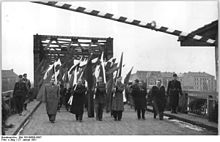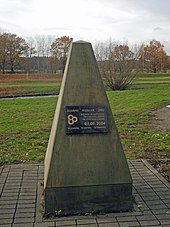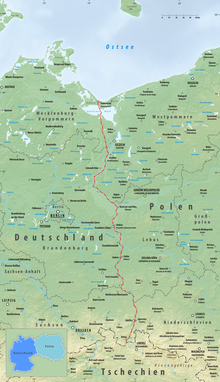Oder–Neisse line
The Oder-Neisse border, today the German-Polish border, runs along the Oder to the confluence of the Lausitzer Neiße, then following it to the Czech border. In its northernmost section, it runs through land areas; in the far north, it divides the island of Usedom. The border is 460.4 km long. Of this, the land section is 51.1 km, the water section by the rivers and canals is 389.8 km, the internal marine waters are 19.5 km, and in the territorial waters of the Baltic Sea six nautical miles (11.1 km).
Even before the Allies' decision on Poland's borders in the Potsdam Agreement of August 2, 1945, the Soviet Union placed the German territory east of the Oder and the Lusatian Neisse (with the exception of the Königsberg area) under Polish administration. The governments of Great Britain and the United States protested this unilateral decision. Nevertheless, in the Potsdam Decisions, the heads of state of the three Allies finally agreed that the Polish state should administer these territories, and determined that the final determination of Poland's western border should be made only in a peace settlement yet to come. In this respect, these territories were not to be considered part of the Soviet-occupied zone.
This was intended to place about a quarter of the German territory in the borders of 1937 under provisional Polish or Soviet administration. De facto, these areas were permanently separated from the previous German territory. The flight and expulsion of Germans from East-Central Europe had already begun at this point. The fact that Poland included the German eastern territories placed under Polish administration in the expulsion area was accepted by the Western Allies. By 1950, about 90 percent of the German population of these areas had been affected.
West of this new border was the Soviet Occupation Zone of Germany from 1945 to 1949 and the GDR from 1949 to 1990. Shortly after their establishment, the governments of Poland and the GDR signed the Görlitz Agreement of 6 July 1950, which recognised the Oder-Neisse line as the final "German-Polish state border". In official parlance, this was called the "Oder-Neisse peace border", although Szczecin lies to the west of the Oder. The Federal Republic of Germany, which was also founded in 1949, did not recognize the Oder-Neisse line as the de facto "inviolable" western border of the People's Republic of Poland until 20 years later, on December 7, 1970, in the Warsaw Treaty, subject to amendment within the framework of a peace settlement.
Since 3 October 1990, the Oder-Neisse border has been the eastern border of the reunified Germany. The course of the border was not changed after 1951.

March of the Polish delegation for the Görlitz Agreement over the Frankfurt Oder Bridge

Commemoration of Poland's accession to the Schengen area at the border triangle Poland - Czech Republic - Germany at the southern end of the Oder-Neisse border

Border between Germany and Poland

Northern end of the German-Polish border at the Baltic Sea
Germany, Poland and Soviet Union until 1945
The areas of the German Reich placed under Polish administration after the Second World War by the Potsdam Decisions, as defined in 1937, comprised the areas of the Prussian provinces of Pomerania, Brandenburg, Lower and Upper Silesia (as parts of Silesia) to the east of the Saxon district of Zittau and the southern part of East Prussia. The population in these areas and in the Free City of Danzig, which had been independent since the Treaty of Versailles, was German-speaking until 1945, except for Polish-speaking portions in Upper Silesia (11%), Danzig (4%), and East Prussia (2%, mostly Masuria).
Poland, reborn after the end of the First World War in 1918, had demanded the annexation of all of Upper Silesia, Posen, West Prussia, Danzig and southern East Prussia at the Versailles Peace Conference. The claims were justified on the grounds of Polish-speaking populations and the fact that these territories had been under Polish rule in earlier centuries. They could not be fully enforced in the peace treaty, especially since the referendums in Upper Silesia, in the Marienwerder voting area, and in the Allenstein voting area resulted in majorities in favor of remaining with Germany. The final course of the border in eastern Upper Silesia was not determined until 1922.
On the eve of the Second World War, the two dictators Adolf Hitler and Josef Stalin defined the political-territorial spheres of interest of the German Reich and the Soviet Union in a secret additional protocol by agreeing on a German-Soviet demarcation line. This demarcation line was largely based on the Curzon Line proclaimed by the Western Allies in 1919, which was based on the ethnographic principle (cf. the adjacent diagram). Russia, under its Prime Minister Ivan Logginovich Goremykin, had already agreed with Roman Dmowski in 1915 on the procedure of using the ethnographic principle to determine Poland's eastern border.
In the secret Additional Protocol, the territories east of the Curzon Line conquered by Poland from 1919 to 1921 (Eastern Galicia in 1919, Volhynia in 1921, the former Russian-Lithuanian Governorate of Vilnius in 1920/22), which had belonged to Old Poland until the partitions of Poland in 1772-1795, were assigned to the Soviet sphere of interest (see Soviet Occupation of Eastern Poland).
In the areas of Poland annexed by Germany as well as in parts of the Generalgouvernement, the National Socialists pursued the goal of complete Germanization. Large parts of the Polish population were expelled from these areas. Parts of the Polish elite were murdered and many Poles were deported to the German Reich for forced labor.
In December 1942, Władysław Sikorski, the prime minister of the Polish government-in-exile in London, called the Oder the "naturally given security line" of Poland in a memorandum.
.png)
Borderlines of Poland between the two world wars and afterwards. Green line: Curzon line proclaimed by the Western Allies on 8 December 1919 as the demarcation line between Soviet Russia and Poland, based on the ethnographic principle. Blue line: the border established after the end of the war until 1923 through territorial acquisitions by General Józef Piłsudski (Eastern Galicia in 1919, Volhynia in 1921 and Vilnius region in 1920/1922) in disregard of the Curzon Line, which had applied until 1 September 1939. Brown line: German-Soviet demarcation line of September 28, 1939. Red line: today's state border of Poland; in the west (left) the Oder-Neisse line. Turquoise area: territorial expansion undertaken by Poland after the end of World War I until 1923. Yellow area: eastern territories of the German Reich claimed by Poland as compensation for the loss of the territories east of the Curzon Line in the borders of 1937 ("westward shift").
Allied policy on Germany up to the Potsdam Conference
The main issue for the three Allies at the Tehran Conference in the winter of 1943 was the division of Germany. Stalin wanted to keep the territories east of the Curzon Line (the parts of eastern Poland inhabited by a majority of White Russians and Ukrainians) that Soviet Russia had ceded to Poland in the 1921 Riga Peace Treaty after the lost Polish-Soviet War of 1920. He sought a boundary between the Soviet Union and the Polish Republic which, with the exception of the Bialystok district and some areas along the San River, corresponded to that already agreed upon in the Ribbentrop-Molotov Pact. Poland was to be compensated for this at the expense of Germany in the west and receive part of the territory which the Versailles Peace Treaty had recognized as German after the First World War. Stalin demanded the Oder as Poland's western border and the Curzon Line as Poland's eastern border, which amounted to a westward shift of Poland.
When the subject of German partition was continued at the Yalta Conference in February 1945, preliminary decisions had already been made. General de Gaulle had told Stalin in Moscow in December 1944 that he had nothing against a German border on the Oder and Neisse. Churchill had explained in the British House of Commons that it would be to Poland's advantage if she were to receive territories in the West that were richer than those she would have to cede in the East. On December 15, 1944, he made a speech in which he advocated the "complete expulsion" of the Germans from the future Polish western territories. Britain approved of the Oder line, including Szczecin, to the Polish government-in-exile. Only apparently the border question was still open, only its exact course was still disputed. Churchill and Roosevelt spoke at Yalta of the "Oder border", Stalin of the "Oder and Neisse". The Polish government-in-exile feared losing eastern Poland if it agreed to the Oder-Neisse border, and held fast to the Riga Peace border in the east. In the west, it demanded East Prussia, Danzig, Upper Silesia, and part of Pomerania. Stalin had set up a Communist government for Poland in July 1944 with the Lublin Committee, which accepted the Curzon Line in the east. In a secret treaty it had settled on the Oder-Neisse border. A settlement for the northernmost section of the Polish border was promised to the committee. On August 28, 1944, its chairman, Edward Osóbka-Morawski, had for the first time publicly demanded the Oder as Poland's western border. Beneš, the president of the Czechoslovak government-in-exile, also made himself an advocate of a westward shift of Poland at the expense of Germany and in favor of the Soviet Union. At the Yalta Conference, the basic decision on the future of Poland and the German eastern territories was finally made by Stalin, Churchill, and Roosevelt, without, however, already determining the course of Germany's eastern border. Germany was to be divided up and Poland was to be moved westwards.
It is unclear when Stalin decided where Poland's new western border was to be and when the Western Allies became aware of the actual future course of the border. A chance find in a Moscow archive proves that Stalin marked the Oder and the Glatzer Neisse as the western border on a map he had worked on with a pencil as late as the summer of 1944.
Search within the encyclopedia